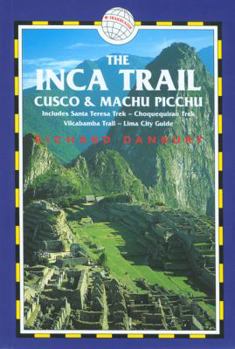The Inca Trail: Cusco & Machu Picchu
This title includes: historical background on the Incas; plans of all the main archaeological sites and comprehensive guides to Lima, Cusco and Machu Picchu; routes from Cusco to Machu Picchu and... This description may be from another edition of this product.
Format:Paperback
Language:English
ISBN:1873756860
ISBN13:9781873756867
Release Date:October 2005
Publisher:Trailblazer Publications
Length:320 Pages
Weight:0.65 lbs.
Dimensions:0.7" x 4.9" x 7.2"
Customer Reviews
4 ratings
Visiting Peru
Published by Thriftbooks.com User , 14 years ago
This book is quite informative! It gave more detail for hikes than we need, since we will have a tour guide. I'm sure anyone without a guide will find this an outstanding book.
Highly recommended!
Published by Thriftbooks.com User , 16 years ago
For someone who only had enough vacation days to hike the Inca Trail with a few days to spare in Cusco, and a single day in Lima, this book was indispensable. The size was perfect for carrying in a daypack with sufficient pages devoted to the history and culture. My friend and I explored many of the restaurants and sites mentioned by the author and all of the descriptions and directions were clear and accurate. I've already lent the book to two other friends who returned from their trips with the same comments. A very efficient guide book for exploring the Inca Trail and surroundings.
The Inca Trail
Published by Thriftbooks.com User , 16 years ago
Fantastic. Thorough. This book will be our constant companion while traveling to the sacred sites in Peru. Thank you. Barb
Sidebar Information Erroneous/Out of Date
Published by Thriftbooks.com User , 17 years ago
As the author of "The Complete Guide to Easter Island" (Easter Island Foundation, 2004), I recently read with keen interest the sidebar "The Incas and Easter Island" in the 2005 edition of "The Inca Trail" (p.97) and thought readers would find it helpful to know that the information in the sidebar is significantly out of date. In one case, it is completely erroneous. While it is true that Thor Heyerdahl compared Inca and Easter Island stonework and, while they are superficially similar, its vitally important to distinguish between the solid stone masonry of the Inca and the rock-filled veneer of Easter Island ahu (platform) construction. Moreover, only one ahu on Easter Island (at Vinapu) really significantly resembles Inca stonework and, besides, the earliest available date for Peruvian polygonal block masonry is after 1440 ce, while that for comparable stonework on Easter Island is c. 1200 ce, so the parallel isn't particularly robust. More crucially, when the author says that "Heyerdahl spectacularly proved that it is possible to float from Peru to Easter Island on a raft when in 1948 he did just that aboard his reed raft, Kon Tiki", the reader should know that Heyerdahl's expedition did not go to Easter Island. Nor was Easter Island the expedition's intended destination. The Kon-Tiki raft actually beached in the Tuamotus, 2000 miles northwest of Easter Island. True, Heyerdahl proved that a raft could drift from South America westward into the Pacific, but rarely given much attention is the fact that the Kon-Tiki raft had to be towed 50 nautical miles out to sea by a tug boat before beginning his long and courageous journey because of the strong Humboldt Current off the Peruvian coast. Hardly representative of the way ancient Peruvian seafarers would have dealt with the daunting task, assuming they even could have. Finally, to say that it is sad that Heyerdahl's theories have never been accepted by mainstream scientists makes it sound as if he's a misunderstood maverick who will one day be vindicated -- yet I'm constrained to point out that his theories and methods are understood unequivocally and few lament the loss of, say, the Ptolemaic view of the cosmos, precisely because it was wrong and still is. The problem with Heyerdahl's theories isn't just that no Peruvian evidence has turned up on Easter Island but that an overwhelming array of other evidence -- linguistic, socio-cultural, osteological, and genetic -- proves conclusively that the Easter Islanders are the direct descendants of Polynesians. Heyerdahl tried to assert that two waves of settlers -- one Polynesian, another South American -- visited Easter Island (a theory he tried to bolster by references to Easter Island legends which have turned out to be unsupported by scientific fact). But this was emphasized only after the evidence indicating Polynesian origins proved impossible to refute. And while the presence of the sweet potato on Easter Island clearly suggests some form of





